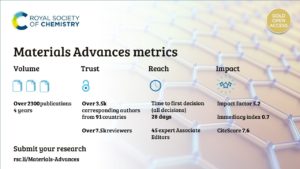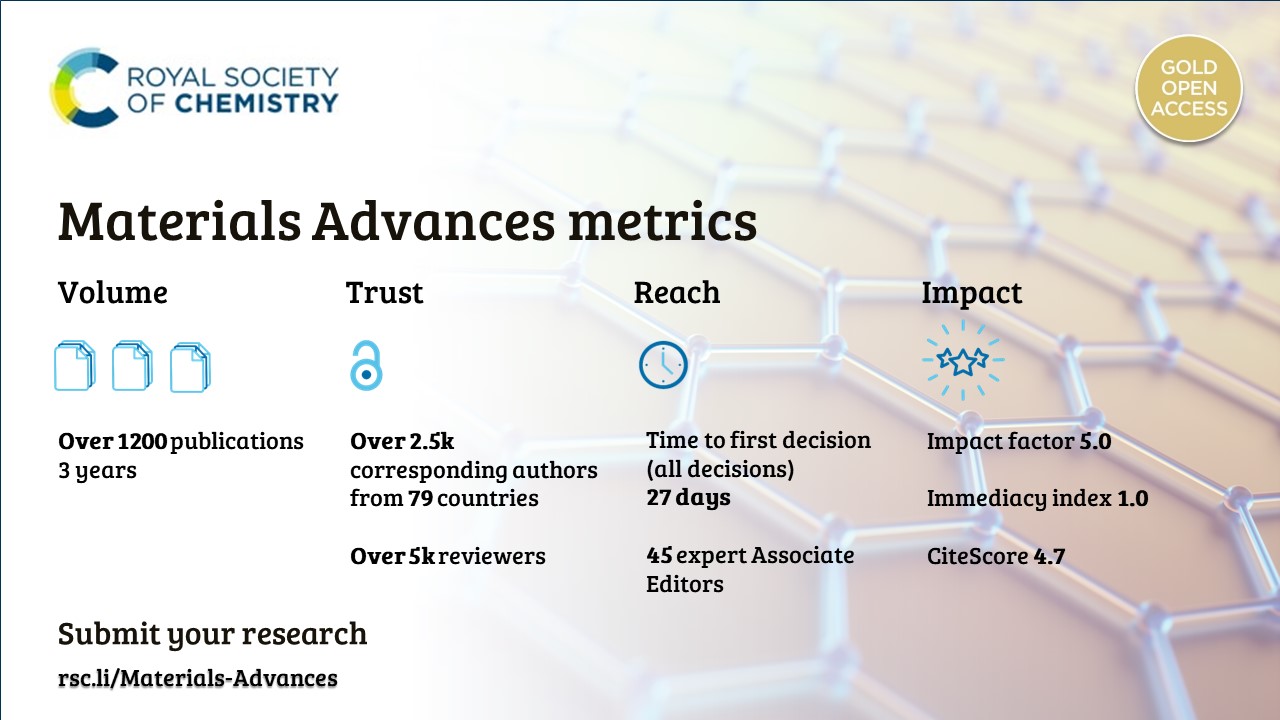We are delighted to announce that the 2013 Impact Factor* for Journal of Materials Chemistry is 6.626! Journal of Materials Chemistry is the parent journal of the Journal of Materials Chemistry family, Journal of Materials Chemistry A, B & C. These three new journals will receive their first individual Impact Factors next summer in the 2014 Journal Citation Reports®.
Journal of Materials Chemistry has again recorded its highest ever value of Impact Factor, which represents a continued increase over previous years. We would like to thank our authors, referees, readers and Editorial and Advisory Board members for all your contributions to the success of the Journal of Materials Chemistry family.
We are also delighted to announce the 2013 Immediacy Indexes# for the Journal of Materials Chemistry family of journals:
Journal of Materials Chemistry A – 1.238
Journal of Materials Chemistry B – 0.889
Journal of Materials Chemistry C – 0.951
We envision these successes to continue with the three new journals. Submit your next high impact paper to Journal of Materials Chemistry A, B or C and enjoy all the benefits of being a Royal Society of Chemistry author!

Find out how other Royal Society of Chemistry journals are ranked in the latest Impact Factor release.
Top cited Journal of Materials Chemistry A, B and C articles:
Feature Articles
LiMnPO4 – A next generation cathode material for lithium-ion batteries
Vanchiappan Aravindan, Joe Gnanaraj, Yun-Sung Lee and Srinivasan Madhavi
J. Mater. Chem. A, 2013,1, 3518-3539
Carbon “quantum” dots for optical bioimaging
Pengju G. Luo, Sushant Sahu, Sheng-Tao Yang, Sumit K. Sonkar, Jinping Wang, Haifang Wang, Gregory E. LeCroy, Li Cao and Ya-Ping Sun
J. Mater. Chem. B, 2013,1, 2116-2127
Development of high performance OLEDs for general lighting
Hisahiro Sasabe and Junji Kido
J. Mater. Chem. C, 2013,1, 1699-1707
Full Papers
Synthesis and crystal chemistry of the hybrid perovskite (CH3NH3) PbI3 for solid-state sensitised solar cell applications
Tom Baikie, Yanan Fang, Jeannette M. Kadro, Martin Schreyer, Fengxia Wei, Subodh G. Mhaisalkar, Michael Graetzel and Tim J. White
J. Mater. Chem. A, 2013,1, 5628-5641
Biopolymer functionalized reduced graphene oxide with enhanced biocompatibility via mussel inspired coatings/anchors
Chong Cheng, Shengqiang Nie, Shuang Li, Hong Peng, Hang Yang, Lang Ma, Shudong Sun and Changsheng Zhao
J. Mater. Chem. B, 2013,1, 265-275
Laminated magnetic graphene with enhanced electromagnetic wave absorption properties
Xin Sun, Jianping He, Guoxian Li, Jing Tang, Tao Wang, Yunxia Guo and Hairong Xue
J. Mater. Chem. C, 2013,1, 765-777
*The Impact Factor provides an indication of the average number of citations per paper. Produced annually, Impact Factors are calculated by dividing the number of citations in a year by the number of citeable articles published in the preceding two years. Data based on 2013 Journal Citation Reports®, (Thomson Reuters, 2014). There will be an impact factor for either Journal of Materials Chemistry, or Journal of Materials Chemistry A, B and C, every year. The 2014 Journal Citation Reports® will include the last impact factor for Journal of Materials Chemistry, and the first impact factors for the three new journals.
#Immediacy Index is the numbers of citations in a given year to papers published in that year.
Follow the latest journal news on Twitter @JMaterChem or go to our Facebook page.



















